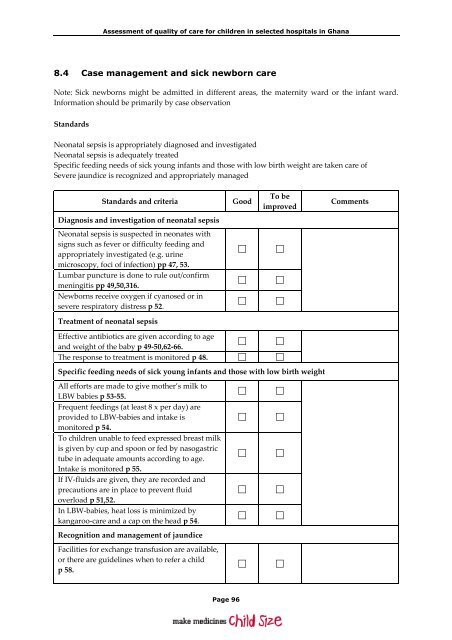Assessment of quality of care for children in selected hospitals in ...
Assessment of quality of care for children in selected hospitals in ...
Assessment of quality of care for children in selected hospitals in ...
You also want an ePaper? Increase the reach of your titles
YUMPU automatically turns print PDFs into web optimized ePapers that Google loves.
<strong>Assessment</strong> <strong>of</strong> <strong>quality</strong> <strong>of</strong> <strong>care</strong> <strong>for</strong> <strong>children</strong> <strong>in</strong> <strong>selected</strong> <strong>hospitals</strong> <strong>in</strong> Ghana8.4 Case management and sick newborn <strong>care</strong>Note: Sick newborns might be admitted <strong>in</strong> different areas, the maternity ward or the <strong>in</strong>fant ward.In<strong>for</strong>mation should be primarily by case observationStandardsNeonatal sepsis is appropriately diagnosed and <strong>in</strong>vestigatedNeonatal sepsis is adequately treatedSpecific feed<strong>in</strong>g needs <strong>of</strong> sick young <strong>in</strong>fants and those with low birth weight are taken <strong>care</strong> <strong>of</strong>Severe jaundice is recognized and appropriately managedStandards and criteriaGoodTo beimprovedCommentsDiagnosis and <strong>in</strong>vestigation <strong>of</strong> neonatal sepsisNeonatal sepsis is suspected <strong>in</strong> neonates withsigns such as fever or difficulty feed<strong>in</strong>g andappropriately <strong>in</strong>vestigated (e.g. ur<strong>in</strong>emicroscopy, foci <strong>of</strong> <strong>in</strong>fection) pp 47, 53.Lumbar puncture is done to rule out/confirmmen<strong>in</strong>gitis pp 49,50,316.Newborns receive oxygen if cyanosed or <strong>in</strong>severe respiratory distress p 52.Treatment <strong>of</strong> neonatal sepsisEffective antibiotics are given accord<strong>in</strong>g to ageand weight <strong>of</strong> the baby p 49‐50,62‐66. The response to treatment is monitored p 48. Specific feed<strong>in</strong>g needs <strong>of</strong> sick young <strong>in</strong>fants and those with low birth weightAll ef<strong>for</strong>ts are made to give mother’s milk toLBW babies p 53‐55.Frequent feed<strong>in</strong>gs (at least 8 x per day) areprovided to LBW‐babies and <strong>in</strong>take ismonitored p 54.To <strong>children</strong> unable to feed expressed breast milkis given by cup and spoon or fed by nasogastrictube <strong>in</strong> adequate amounts accord<strong>in</strong>g to age.Intake is monitored p 55.If IV‐fluids are given, they are recorded andprecautions are <strong>in</strong> place to prevent fluidoverload p 51,52.In LBW‐babies, heat loss is m<strong>in</strong>imized bykangaroo‐<strong>care</strong> and a cap on the head p 54.Recognition and management <strong>of</strong> jaundiceFacilities <strong>for</strong> exchange transfusion are available,or there are guidel<strong>in</strong>es when to refer a childp 58.Page 96
















